When a brewer’s reputation also depends on a bar’s cleanliness
Best Draft (name changed for the confidentiality of the business) beers are served in a wide number of taprooms, pubs, restaurants, hotel bars. As a brewer who has built a reputation for great tasting beer, Best Draft goes to great lengths to produce high quality products for its consumers. To think, however, that their efforts can be easily compromised by a bar’s dirty lines is really quite upsetting.
Hygiene is critical insuring good quality beer, from the first step in brewing to the first sip by the customer, and this includes draft beer dispensing systems. Improper line maintenance favors the development of Acetic bacteria, lactic bacteria such as Lactobacilli, Pediocuccus responsible for undesirable mist or off-flavors, and even worse if beerstone takes a hold.
To be safe, line cleaning should take place every couple of weeks, at least. Proper cleaning procedures involve disconnecting the lines that run from keg to tap, so they can be emptied, rinsed and cleaned, dried, and reconnected, before being returned to service. The whole process involves time and wasted beer, impacting a bar’s margin.
On the other hand, infrequent cleaning may lead to deteriorated beer, which impacts consumption (a bar’s bottom line, again) and the brewer’s reputation. And no one wants to be known for “skunk” beer!
As a service to client bars and to ensure a proper cleaning routine, Best Draft manages these maintenance operations when it comes to distributors and beer tap installers, with the cleaning costs built into the beer price. The keg lines, however, are still the responsibility of each establishment.
Most places rinse their beer lines whenever a keg is replaced, but depending on the season, weather, and the beer type, a keg can be changed every couple of days, once a week, or stay in place for longer. Since that rinse takes time and wastes some beer, can Best Draft be certain that this minimum precaution is taken every time?
Overall, the adequate cleaning routine is season, outlet, consumption and cleaning technique dependent, while representing a short-term cost for some and a long-term savings for everyone: not a straightforward formula.
Bad tasting beer signals a problem
Jimmy’s Bar (name changed for confidentiality) is a major outlet for Best Draft’s beer. Recently, representatives from Best Draft tasted their own beer at Jimmy’s and found it spoiled. If they weren’t satisfied, why would the bar’s customers be?
Best Draft decided to take action and investigate the conditions that most influence spoilage, with a scheduled microbial sampling campaign they could pilot directly.
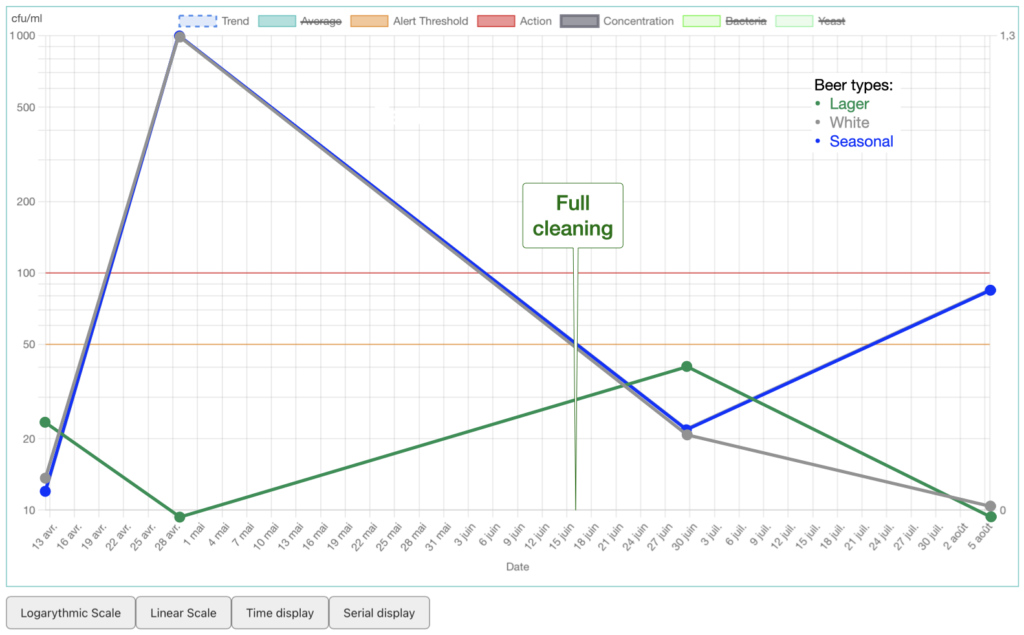
A plan to quietly test the microbes in beer right at the tap in service
To proceed with the investigation, Best Draft needed a testing system with the following characteristics:
- Simple to apply on-site with minimum training
- Capable of counting microorganisms in beer
- Discrete enough to allow testing anytime, even in the presence of consumers, without creating anxiety
- Recording of the parameters most influencing spoilage, such as frequency of keg replacement, cleaning type (hand, pressurized or re-circulating pumps), last cleaning, outlet identity, etc.
Getting the information to optimize cleaning
For Best Draft, the purpose of the project was to optimize cleaning plans by better understanding:
- the relationship between microbial content and spoiled beer taste
- the relationship between cleaning routine and microbial content
A smart plan to test anywhere, organize the data, and track trends
Best Draft selected the LET’S GO smart microbiology plan from BioMire as the most appropriate for the project.
The plan includes:
- stand-alone microbiology quantitative test devices suited for on and off-site testing, and on which all aerobic micro-organisms can grow
- the nomad Smart Microbiology App for mobile, paperless, pen-free recording
- a nomad Online account for managing test information, IA-assisted colony counting and trend analysis
It was decided that a designated staff member would visit bars on chosen dates, test the beer taps and send the records to Mike, the program manager.
A new bar as investigation site to set the reference
A recently opened recreation center volunteered to have its bar monitored 7 days a week for 4 months, as a reference.
At this location, the kegs were stored in the basement, from which 3 beer lines and 1 drinking water line led to the bar, 5 meters above. The beer lines were rinsed with water at each keg change, at least once per week.
Sampling and testing were conducted during normal opening hours, without interrupting regular activities.
Each of the beer taps was tested on a regular basis (almost monthly) from April to August.
The lines underwent full cleaning with pressurized tanks pushing the cleaning and decontaminating solutions, up until mid-June.

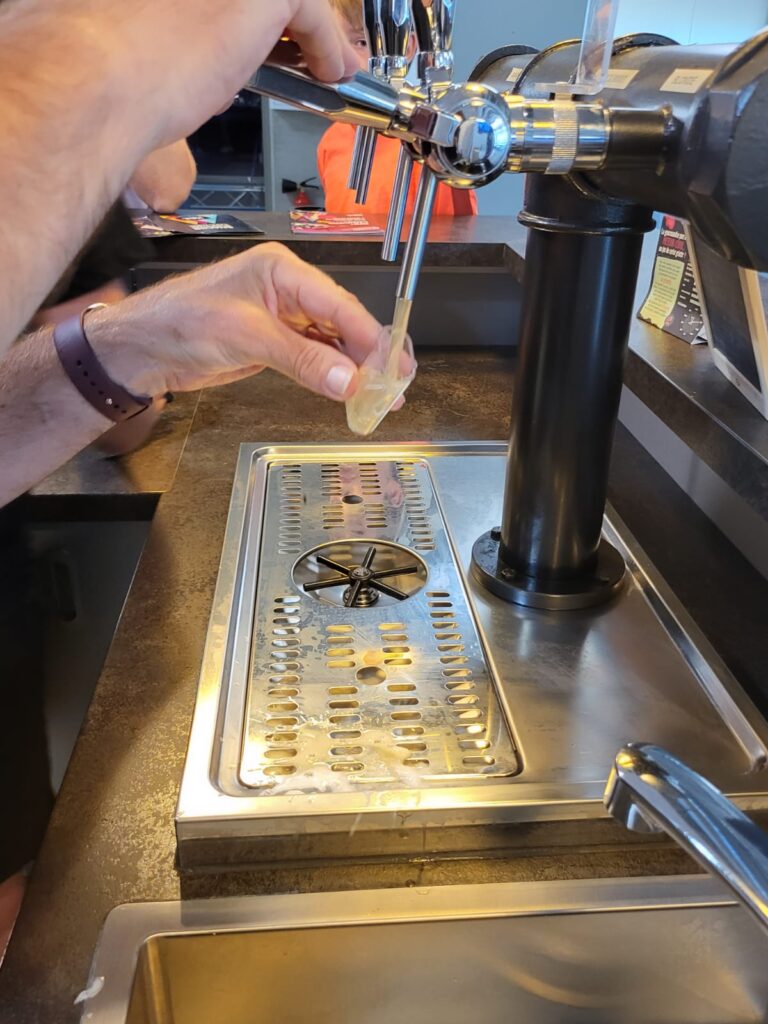
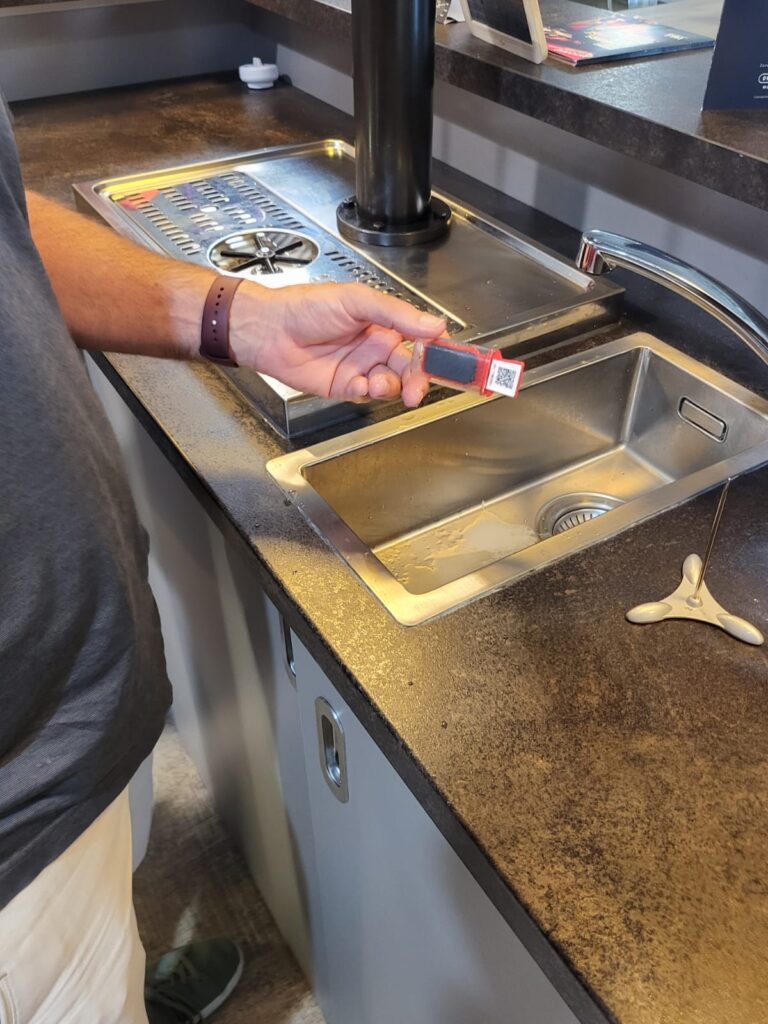
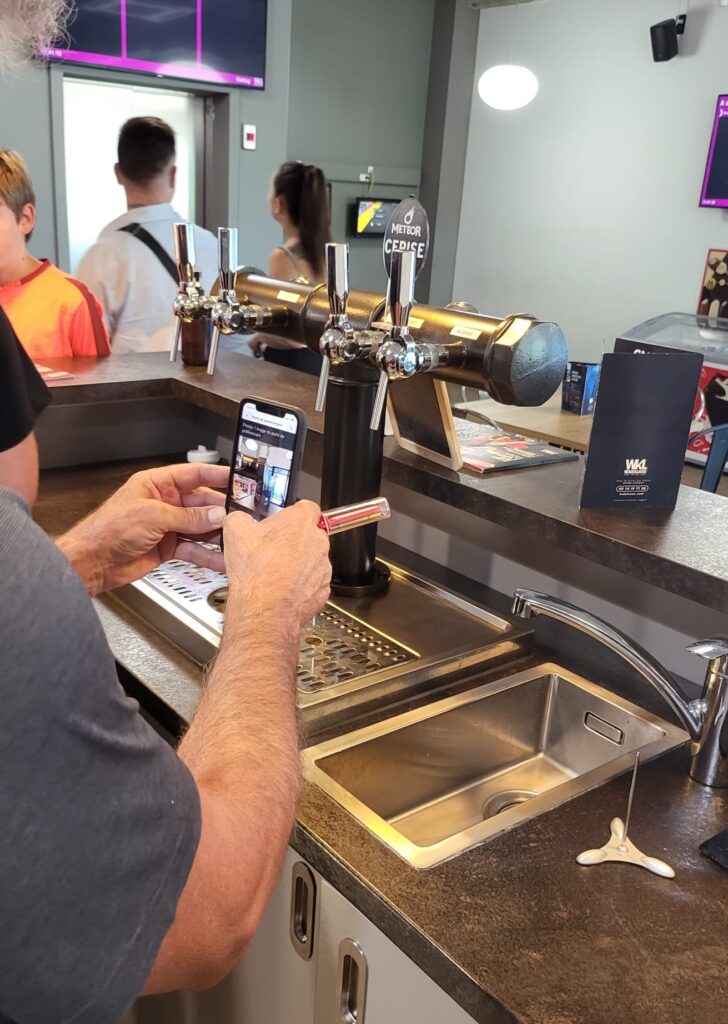
Not all products have the same problems, but standard cleaning routines need improvement
At the end of the investigation, Best Draft found result showing counts could vary significantly, from 5 colony forming units (cfu) per ml to “Too Numerous To Count” (TNTC) i.e. > 100 cfu/ml.
Best Draft’s lager, most popular with the highest throughput, saw counts that were stable with a median around 25 cfu/ml.
The white and seasonal beers had initially similar counts i.e. < 20 cfu/ml, before results spiked to TNTC a month later, with no decrease thereafter. In the testing period, those 2 beers were, despite sustained demand, less popular than the lager.
Shortly after full line decontamination, all results dropped to < 40 cfu/ml, which represented:
- no change for the lager, which was fine to start with
- a significant drop in counts for the other 2 beers, back to normal baseline levels
4-6 weeks after full sanitation, however, the seasonal beer counts increased to TNTC again.
Since the recreation center was open 7 days a week, the investigation could not establish a relationship between closing days and contamination increases due to the lines being idle.
In addition, the count trend highlighted that rinsing the lines at each keg change was insufficient to prevent micro-organism growth and that complete cleaning at least once a month was necessary for 2 beer types.
Happily, on none of the test occasions did the public pay much attention to the fact that lab-quality microbial testing was going on behind the bar!
Quantitative data to support new cleaning routines
Best Draft and their volunteer customer concluded the investigation with new, actionable and quantitative information, supporting the appropriate cleaning routine for the beer lines.
Since the tests were able to be carried out without drawing unnecessary attention from the public, Best Draft and the recreation center learned the control method could be implemented without any concern for disruptions in normal operations.
Lower demand leads to less cleaning and more microbial growth
Best Draft learned that the beers less in demand were the most problematic.
Once the counts increase by 1/2 log to 1 log over the baseline, they did not come back down spontaneously.
Counts above 100 cfu/ml are typically indicative of conditions where biofilm can grow on the piping material. Once a biofilm is installed, it is very difficult to eliminate with chemicals. Specific cumbersome enzymatic treatments have shown to be efficient, but a mechanical action is usually required.
Demand and dispensation issues applied to other industries where product diversity can create risks for microbial growth
The relationship between product quality and the amount demand put on a dispensation equipment is not unique to beer taps, but can also be observed in water purification and distribution systems, soft-drink fountains, water fountains, etc.
Although it may be tempting to diversify an offering or the number of points-of-use, this diversification comes with an increased risk of microbial proliferation, product spoilage culminating in difficult-to-remove biofilm formation, and can host other non-biofilm forming spoilage micro-organisms.
Since we only find what we look for, regular monitoring of points-of-use and points-of- consumption, (easy to do with nomad On-Site Microbial Test Kits!) is recommended to prevent bad experiences.
Microbe-wise – A quick look at Pediococcus
Pediococcus (referred to by brewers as “Pedio”) belongs to the group of lactic acid bacteria (LAB) which includes also Lactobacillus and Leuconostoc.
They grow anaerobically but can also grow in the presence of oxygen, grow best at 22°C, are native to plant material and fruits and strains found in beer are hop tolerant and ferment sugars to lactic acid, which gives a sour flavor.
Pediococcus species are used in silage inoculants, as probiotics, and commonly added as beneficial microbes in the creation of sausages, cheeses and yogurts.
They are usually considered contaminants of beer and wine, although their presence is sometimes desired in the production of Belgian style beers where additional acidity is desirable. Certain Pediococcus produce diacetyl which gives a buttery or butterscotch aroma to some wines (such as Chardonnay) and a few styles of beer.
They are seen as a major source of beer contamination in commercial breweries due to their ability to adapt to and survive in beer.
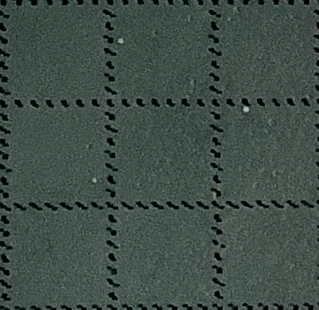
Disclaimers
This Use Case is based on a true story! (Though we edited it for readability and, of course, for confidentiality.) We like to share stories about real situations because we think they help translate raw facts into helpful insight and understanding. We’re providing this use case as an illustration, but it does not imply that the same conclusions can be made in similar cases. We will be happy to discuss it, however, as well as how the particulars of this case might be transferable to your situation—so don’t hesitate to contact us! Also, please be aware that we do sometimes use automatic translations, which might slightly distort the information.


